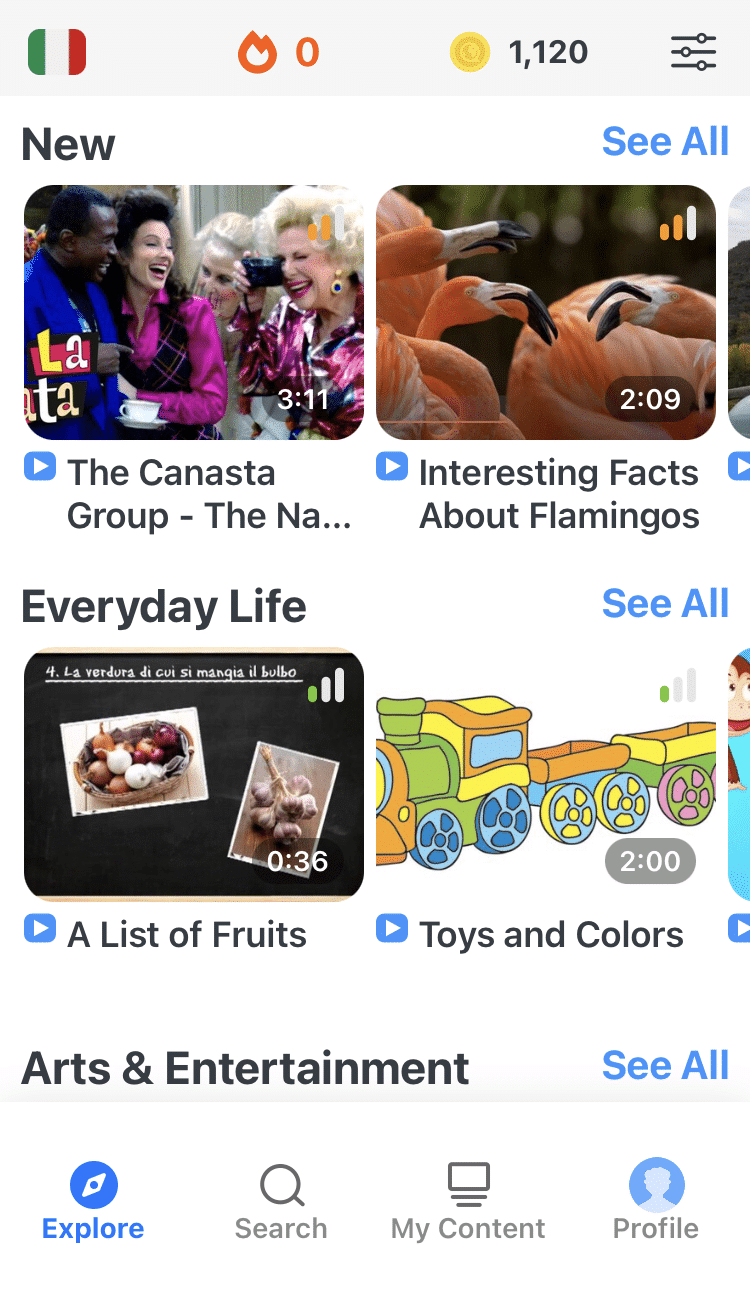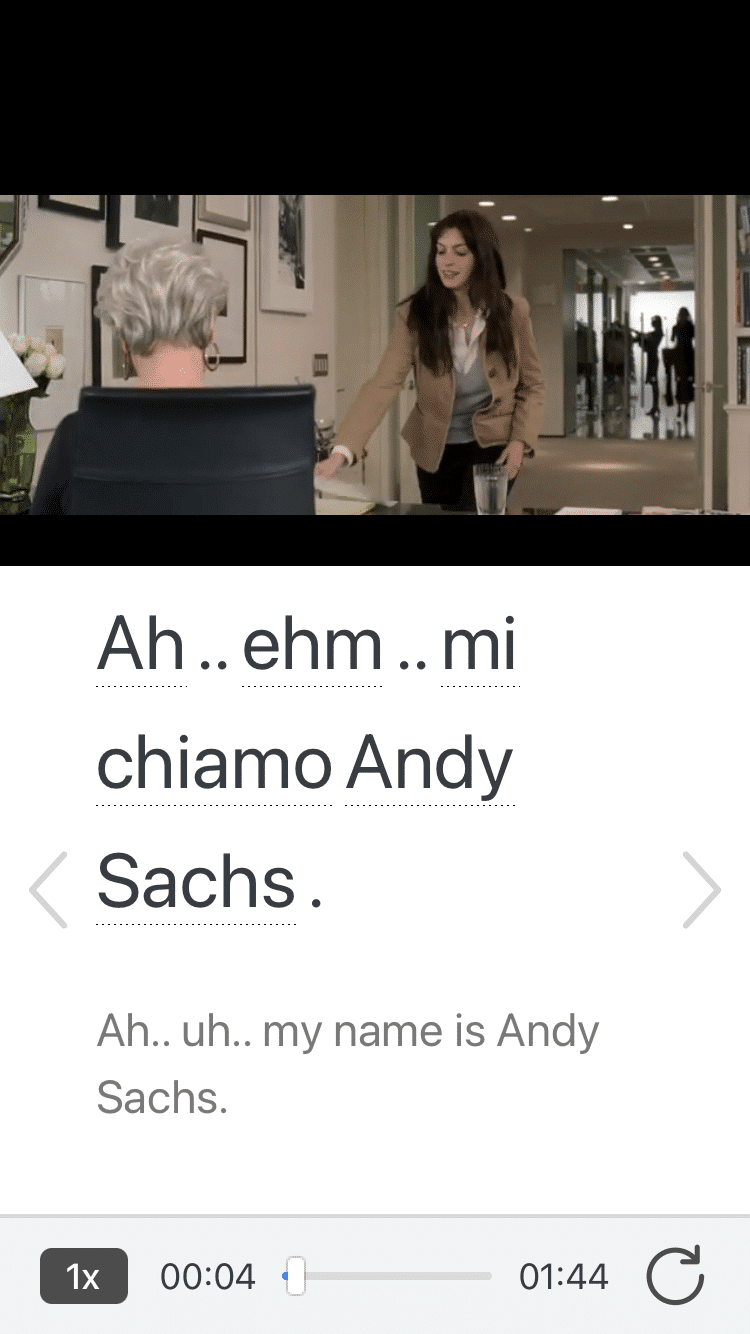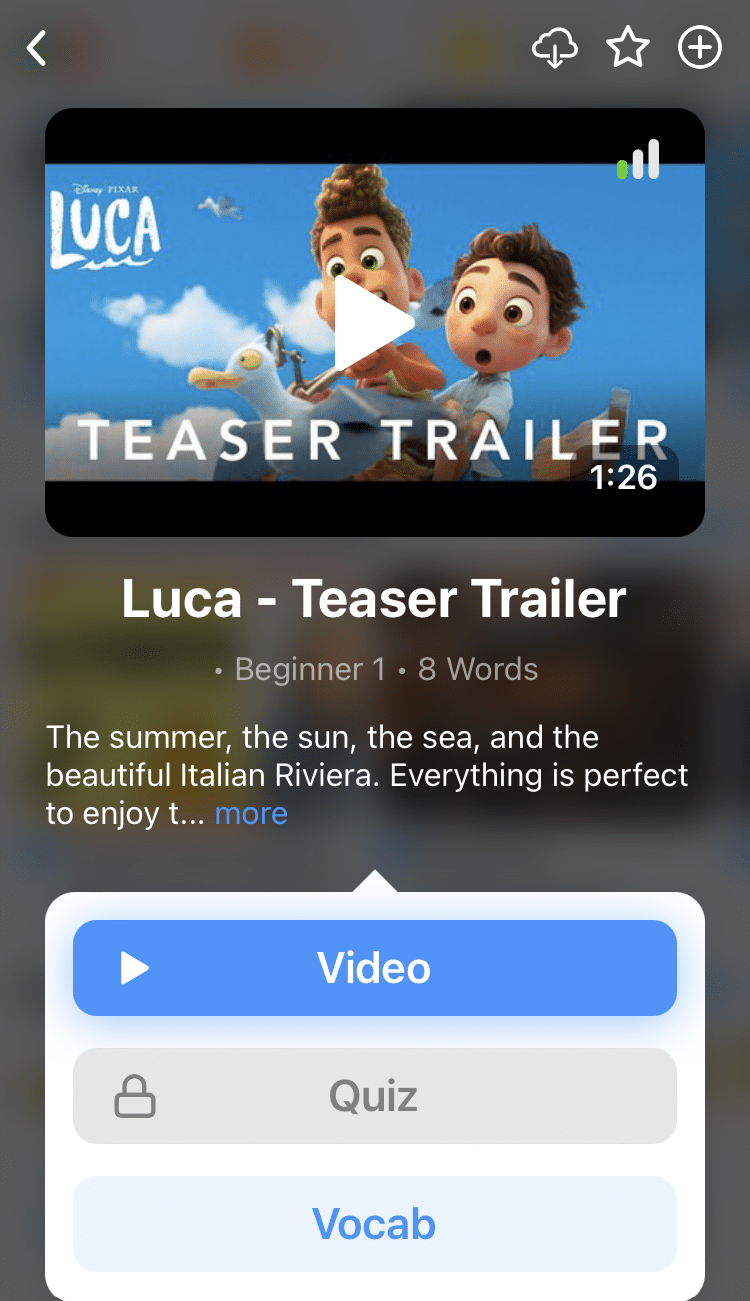
20 Ways to Say Cool in Italian (With Audio)
How cool is that!
My parents are cool with that.
Is everything cool here?
Depending on context, the word “cool” can mean awesome, fine, okay, cold, chill or fashionable.
The same is true for cool in Italian. While there’s no direct translation, Italian boasts an array of cool words to describe the trendy, fashionable, awesome, legendary and fantastic.
In this post, we’ll share 20 different ways to say cool in Italian, a guide to understanding cool culture in Italy and resources you can use to learn these words and expressions.
Contents
- How to Talk Cool in Italian Like a Cool Cat
- 1. Fico — Cool
- 2. Figata — The bomb
- 3. Massimo — The ultimate/The best
- 4. Bello — Beautiful
- 5. Mito / Mitico — Epic/Legendary/Mystical
- 6. Eccezionale — Exceptional
- 7. Straordinario — Extraordinary
- 8. Fantastico — Fantastic
- 9. Forte — Great
- 10. Grande — Big/Great
- 11. Splendido — Splendid
- 12. Frescone — Cool Guy/Don Juan
- 13. Bellillo — Big Guy
- 14. Ganzo — Cool
- 15. Togo — Cool
- 16. Andare di moda — To be trendy
- 17. Del momento — Of the moment
- 18. Tutto a posto? — Is everything cool/good/okay?
- 19. Fresco — Cool/Cold/Fresh
- 20. Cool — Cool
- Cool Culture in Italy
- Multi-media Resources for Practicing Cool in Italian
- And One More Thing...
Download: This blog post is available as a convenient and portable PDF that you can take anywhere. Click here to get a copy. (Download)
How to Talk Cool in Italian Like a Cool Cat
Knowing the context behind these words is important. Some words are only used in specific regions of Italy and others are more commonly used by certain generations than others.
Let’s take a look at 20 epic words you can start using to make your Italian sound awesome!
1. Fico — Cool
The closest approximate translation for the word “cool” in Italian is fico. In the south, it’s pronounced figo .
It can be used an adjective, as in:
Che ragazzo fico! (What a cool guy!)
Che fica quella macchina! (That car is cool!)
When used as an adjective, the noun and adjective must agree in gender and quantity.
It’s important to note that fica/figa is a vulgar slang word for a woman’s intimate parts. If you use the word with no context—as in che fica! —it may offend.
You can also use fico as a noun to describe a really cool person.
Il tuo amico è un gran fico. (Your friend is a cool dude!)
If you use the term this way, it’s definitely viewed as a form of flirtation. Proceed with caution.
You may hear it used as a feminine noun among friends, mostly in informal situations by young people in Italy. For example, you may hear a young person say to their friend Tua sorella è una figa (Your sister is really beautiful).
However, adults tend to avoid using this expression as it can sound rude. So depending on who you are talking to and your respective ages, it’s probably best to avoid using this expression in Italy.
To add emphasis, use the superlative form in Italian.
Che film fighissimo! (What a cool movie!)
Era una macchina fichissima! (It was the coolest car!)
Note that, mostly, young people use the word fico/figo. If you want to sound like someone in their twenties or younger, use fico to express cool in Italian. If you prefer a more mature effect, use one of the adjectives below, including splendido and fantastico .
2. Figata — The bomb
Figata is slang. Used mostly by young people, a figata is something really, really cool.
Che figata quella festa ieri! (That party last night was the bomb!)
Questa macchina è una figata! (This car is the bomb!)
Other versions of figata to describe people include fighetto (hottie) and figaccione (hunk).
Quel fighetto è tuo amico? (Is that hottie your friend?)
Tuo fratello è un vero figaccione! (Your brother is a real hunk!)
3. Massimo — The ultimate/The best
Massimo literally means maximum in Italian. When used to describe certain features, it can mean cool or the best.
Tu sei il massimo! (You’re the best!)
Quel film ieri era il massimo! (That movie yesterday was the ultimate!)
Mia madre è il massimo! (My mom is the ultimate!)
4. Bello — Beautiful
Bello, meaning beautiful, is a ubiquitous form of praise in all regions of Italy. When in doubt, use bello to describe a cool person, place or thing. As with all adjectives, bello must agree with the noun it describes.
Che bella cosa! (What a beautiful thing!)
Il surfista era bellissimo! (The surfer was beautiful!)
5. Mito / Mitico — Epic/Legendary/Mystical
To really heap on the praise, call someone mitico. It means mythical and roughly translates to mean legendary in English.
You can use it as an adjective, as in:
Lo spettacolo è stato mitico! (The concert was epic!)
Quella macchina da corsa è mitica! (That race car is legendary!)
Or, you can use the noun form, mito, as in:
Quella donna è così bella; è un mito. (That woman is so beautiful; she’s a legend.)
Ma come sei bravo! Sei un mito! (How great you are! You’re a legend!)
6. Eccezionale — Exceptional
Eccezionale is a more mature way to call something cool in Italian. You can use it the same way you’d use complimentary adjectives, including bello.
La nostra cena è stata eccezionale. (Our dinner was exceptional.)
Quegli insegnanti sono eccezionali. (Those teachers are exceptional.)
7. Straordinario — Extraordinary
For variation, you can use straordinario in place of eccezionale.
Il mio ragazzo è straordinario. Mi ha comprato un pony! (My boyfriend is extraordinary! He bought me a pony!)
Adoro i miei genitori. Sono straordinari! (I love my parents. They’re extraordinary!)
8. Fantastico — Fantastic
Fantastico, meaning fantastic, is similar to straordinario. An adjective reserved for great praise, fantastico describes cool things without sounding juvenile.
Mertens, il calciatore, è fantastico. (The soccer player, Mertens, is fantastic.)
Guidare una Ferrari è stata la cosa più fantastica della mia vita. (Driving a Ferrari was the most fantastic thing in my life!)
9. Forte — Great
Forte literally means “strong” but is used in Italian to say “great,” often as a form of praise.
Bradley Cooper è stato fantastico nel film. È forte! (Bradley Cooper was fantastic in the film. He’s great!)
Mia madre ha preparato cinque torte oggi. È fortissima! (My mother made five cakes today. She’s great!)
10. Grande — Big/Great
After a major feat or performance, you might call someone grande (big/great) or even grandissimo (super big/great).
Quello sprint è stato fantastico. Usain Bolt è grande! (That sprint was fantastic. Usain Bolt is great!)
I Lakers sono grandissimi quest’anno. (The Lakers are super big this year.)
11. Splendido — Splendid
Splendid can be used in the same way as fantastico or straordinario.
La performance di Timothée Chalamet è stata splendida. (Timothée Chalamet’s performance was splendid.)
Quanto è stato splendido quel pranzo! (How splendid was that lunch!)
12. Frescone — Cool Guy/Don Juan
Frescone is a Neapolitan word for a really cool guy with a slick sense of fashion. It’s generally not used to refer to women. It can also be used sarcastically.
Con questo nuovo look sei proprio un frescone! (With this new look, you’re a real Don Juan!)
Quel frescone non ha nemmeno una macchina. (That cool guy doesn’t even have a car.)
*Note that frescone is different from the word fregnone, which in Roman dialect means “fool.”
13. Bellillo — Big Guy
Bellillo is also a southern Italian term for a guy who often owns cool things.
Hai comprato una nuova macchina? Vuoi fare ‘o bellillo? (You bought a new car? Are you trying to play the big guy?)
Ciccio è un vero bellillo. Ha tre ragazze e una Ducati. (Frankie is a really big guy. He has three girlfriends and a Ducati.)
14. Ganzo — Cool
Ganzo means cool in the Tuscan dialect. Initially, it meant lover—as in Maria ha un ganzo (Maria has a lover), or Francesco ha una ganza (Francesco has a lover). Over time, it came to also mean that someone or something was very cool. Certain generations in rural parts of Tuscany still use the word.
È molto ganza questa macchina! (This car is very cool!)
È molto ganzo questo cellulare! (This cell phone is very cool!)
Con la barba sei un vero ganzo! (With the beard, you’re a real cool guy!)
15. Togo — Cool
Togo is an Italian word used to describe something very elegant, chic and even super cool.
Lei sa surfare? Che ragazza toga! (She can surf? What a cool girl!)
Mi piace molto quella borsa Chanel. È molto toga. (I really like that Chanel purse. It’s very cool.)
Guarda quella Ferrari! Che toga! (Look at that Ferrari! How cool!)
16. Andare di moda — To be trendy
To express that something is in fashion or trendy, you say it’s di moda , using the verb andare (to go). Note that the subject and verb must agree when you use the phrase andare di moda.
When the trendy thing you’re describing is singular, you say:
Nel 2023 va di moda il rossetto rosso. (In 2023, red lipstick is trendy.)
Va molto di moda portare uno zaino adesso. (It’s very trendy to wear a backpack now.)
When the trendy things are plural, you say:
Vanno di moda le unghie lunghe. (Long nails are trendy.)
Le minigonne andavano di moda negli anni ’60. (Mini-skirts were trendy in the 1960s.)
17. Del momento — Of the moment
To further reiterate that something or someone is the “it” obsession of the moment, you can add this phrase. You’ll often find it used in magazine or newspaper lists that describe the best products of the moment.
Billie Eilish è la cantante più interessante del momento. (Billie Eilish is the most interesting singers of the moment.)
I capelli rossi sono la moda del momento. (Red hair is of the trend of the moment.)
18. Tutto a posto? — Is everything cool/good/okay?
Tutto a posto is a fairly informal way of asking someone if everything is cool in Italian.
La tua faccia è rossa. Tutto a posto? (Your face is red. Is everything cool?)
Maria ti ha sentito urlare. Tutto a posto? (Maria heard you yell. Is everything good?)
19. Fresco — Cool/Cold/Fresh
Don’t forget! Cool also refers to temperature. In Italian, the adjective for cool as in temperature is fresco. It can describe weather, food or even people.
Fa fresco fuori. (It’s cool out.)
Posso avere dell’acqua fresca? (Can I have some cold water?)
Mi sono svegliato fresco e pronto! (I woke up fresh and ready!)
20. Cool — Cool
Lastly, cool is now cool even in Italian. The word cool is so well-known all over the world that most young Italians just use the adjective in English. The word cool doesn’t change gender or quantity as an adjective in Italian. It remains cool no matter what it describes.
La tua nuova gonna è davvero cool! (Your new skirt is really cool!)
Ma guarda questo zaino! Che cool! (Look at this backpack! How cool!)
Cool Culture in Italy
Cool means different things to different people across Italy. As with many countries around the world, youth and popular culture define what’s considered cool in Italy. Social media, blogs and celebrity news sites set the tone for cool culture in Italy.
Milan is the country’s fashion epicenter, and the most popular Italian bloggers, including Chiara Ferragni and Mariano di Vaio make Milan their home. Most young people across Italy adore the cool fashion sense of this new, vibrant generation of Italian bloggers.
More mature Italians often revere the classic style of 1950s Dolce Vita era icons, including Sophia Loren and Marcello Mastroianni. In this case, the refined style of Via Borgognona in Rome is the height of cool in Italy.
Italian regions also wear cool differently. The southern region of Italy tends to be flashier than the north. Southern Italians often prefer ruffles, glitter, sparkles and bling. Northern Italians are more understated and monochromatic.
Cool and the words used to express it, change from north to south.
The south of Italy, for example, is famous for its cool rappers, including Liberato and Clementino.
Florence reveres the cool style of Miuccia Prada and the late Salvatore Ferragamo.
Monza, just north of Milan, is home to the famous Formula One race track, which many global fans deem the ultimate cool.
Keep in mind that while American popular culture dominates international trends, Italy has an entire ecosystem of native musicians, artists and Instafamous celebrities.
To find out more and stay up to date with what’s cool in Italy, read the arts and culture sections of notable Italian newspapers.
Multi-media Resources for Practicing Cool in Italian
A great way to identify your own cool style and preferred word use in Italian is to immerse yourself in Italian popular culture.
Listen to Italian Music
If you’re a beginner to intermediate Italian learner, it’s important that you actively listen to Italian music.
Try printing out lyrics from the Italianissima lyrics archives. Read Italian music publications including Rockol, All Music Italia and Billboard Italia.
Find Italian artists that play similar music styles to what you enjoy in your native language. Try identifying at least five artists you think are cool and write a music review for each in Italian, using at least 10 of the cool words from above.
Every year, Italy hosts a popular competition at the Sanremo Music Festival. Artists from all over the country compete for best song of the year. Many of the most famous Italian recording artists including Laura Pausini, Al Bano & Romina and Rocco Hunt have launched their careers there.
Follow the festival on Instagram and create a Spotify list of your favorite Italian songs. The more you listen, the more you’ll learn what’s cool for you in Italian.
Watch Italian Videos
Another way to immerse yourself in the Italian language is to watch Italian videos and see how the language is used by native Italian speakers. Not only will this help you pick up new slang or cool vocabulary and phrases, but it’ll also enable you to identify when and how to use it.
As we have seen, context is very important when speaking another language, especially when using cool words and expressions. It’s important to consider factors like geographical locations and your age or the age of the people around you.
That’s why watching native speakers use the language is the key to unlocking cool Italian words and phrases. There are many resources available online, for example you could watch Italian videos on YouTube or try watching a movie in Italian.
Another useful resource that can help you see how the language is used in context is FluentU.
FluentU takes authentic videos—like music videos, movie trailers, news and inspiring talks—and turns them into personalized language learning lessons.
You can try FluentU for free for 2 weeks. Check out the website or download the iOS app or Android app.
P.S. Click here to take advantage of our current sale! (Expires at the end of this month.)
Read Fashion Blogs in Italian
A new generation of extremely popular Italian fashion bloggers now dominates Italian youth culture today. For many young people across Italy, these blogs are the very definition of cool. The most popular by far is Chiara Ferragni and her blog The Blonde Salad. Her blog is now available in multiple languages.
Try reading in Italian and identify your favorite fashion trends. Alternatively, you can also read the Italian versions of popular international magazines, including Vogue Italia and Vanity Fair.
There’s no single definition for what defines cool in Italian just as there’s no single word for cool.
As you cultivate your personal style and tastes in Italian, you can decide what’s cool for you!
Download: This blog post is available as a convenient and portable PDF that you can take anywhere. Click here to get a copy. (Download)
And One More Thing...
If you're as busy as most of us, you don't always have time for lengthy language lessons. The solution? FluentU!
Learn Italian with funny commericals, documentary excerpts and web series, as you can see here:

FluentU helps you get comfortable with everyday Italian by combining all the benefits of complete immersion and native-level conversations with interactive subtitles. Tap on any word to instantly see an image, in-context definition, example sentences and other videos in which the word is used.

Access a complete interactive transcript of every video under the Dialogue tab, and review words and phrases with convenient audio clips under Vocab.

Once you've watched a video, you can use FluentU's quizzes to actively practice all the vocabulary in that video. Swipe left or right to see more examples of the word you’re on.

FluentU will even keep track of all the Italian words you’re learning, and give you extra practice with difficult words. Plus, it'll tell you exactly when it's time for review. Now that's a 100% personalized experience!
The best part? You can try FluentU for free with a trial.
Start using the FluentU website on your computer or tablet or, better yet, download the FluentU app from the iTunes or Google Play store. Click here to take advantage of our current sale! (Expires at the end of this month.)



